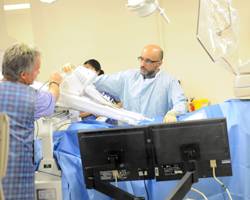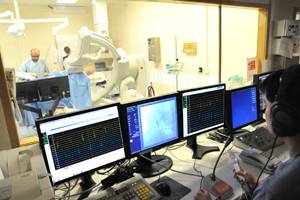Leicester University carries out world's first robotic cardiac catheter ablation
4 May 2010
A pioneering world first robotically controlled cardiac ablation operation is to be conducted at Glenfield Hospital Leicester.
Dr Andre Ng, Senior Lecturer in Cardiovascular Sciences at the University of Leicester and a Consultant Cardiologist at University Hospitals of Leicester NHS Trust, has been chosen to conduct the first clinical procedure using the new Remote Catheter Manipulation System (RCMS) developed by Catheter Robotics Inc. of New Jersey, USA.
 The
procedure involves inserting thin wires, called catheters, into
blood vessels at the top of the groin and navigating into the heart
chambers. Electrodes on the catheters record and stimulate different
regions of the heart to help the doctor identify the cause of the
heart rhythm problem which usually involves an abnormality in the
electrical wiring system of the heart.
The
procedure involves inserting thin wires, called catheters, into
blood vessels at the top of the groin and navigating into the heart
chambers. Electrodes on the catheters record and stimulate different
regions of the heart to help the doctor identify the cause of the
heart rhythm problem which usually involves an abnormality in the
electrical wiring system of the heart.
Once this area is identified, one of the catheters will be placed at the location to ablate or “burn” the tissue to cure the problem. Catheter ablation has been developed and used over the past 2 decades effectively in many patients suffering palpitations due to heart rhythm disturbances.
Dr Ng said: “The new Robotic procedure is an important step forward because, while some procedures are straightforward, others can take several hours. Because X-rays are used to allow the doctor to monitor what is going on inside the patient, it means that doctors standing close to the patient wear radiation shields such as lead aprons which are burdensome. Protracted procedures can lead to clinician fatigue and high cumulative radiation exposure.
“The benefit of the Robotics system to the patient is that movement of the catheter could be done with great precision. It is anticipated that further developments of the system may allow complex procedures to be made more streamlined. On the other hand, benefits to the doctor are that heavy lead aprons would not be necessary as he/ she will be controlling the movements of the catheter using the Remote Controller at a distance from the patient outside the radiation area and that he/ she can be sitting closer to the monitors displaying electrical signals and x-ray images as opposed to standing at some distance across the room from them which is current practice.”

Two other remote navigation systems are commercially available but one uses a huge magnetic field to control a magnetic tip catheter whilst the other uses a large deflectable sheath to move the catheter. The RCMS has the benefit of using standard EPS catheters which can be dismounted and remounted onto the system with ease. The technology has obtained CE mark through rigorous bench safety testing and pre-clinical studies and has now arrived at a stage where it can be applied to clinical procedures.
Further clinical trials into the use of the RCMS (which is distributed in the UK by Dot Medical) will be conducted with the support of the new Biomedical Research Unit, a collaboration between the University and the Hospitals Trust.